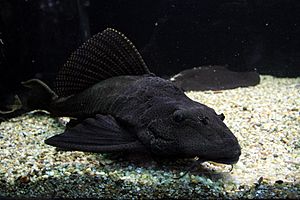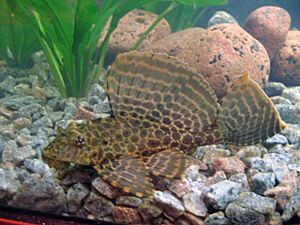Pterygoplichthys gibbiceps facts for kids
Quick facts for kids Pterygoplichthys gibbiceps |
|
|---|---|
 |
|
| Scientific classification |
The Pterygoplichthys gibbiceps is a type of armored catfish. It comes from South America, living in countries like Brazil, Ecuador, Peru, and Venezuela. You can find it in the Orinoco and Amazon basin river systems.
This fish has a very large fin on its back. It also has a noticeable hump or crest near its head. Adult fish can grow up to 50.0 centimetres (19.7 in) long. They can also live for more than 20 years.
The P. gibbiceps looks like a typical pleco fish. It has large, irregular brown spots on a yellowish background. This makes it look a bit like a honeycomb. As the fish gets bigger, its spots become smaller.
Like most plecos, this species mainly eats plants. However, it will also eat dead animals if it finds them. In the wild, these fish swim together in groups. They like slow-moving rivers in the Amazon and Orinoco systems. During the wet season, they also go into flooded areas. When the dry season comes, P. gibbiceps can dig burrows. These burrows are about 1 meter long in mud banks. They use these burrows to rest during the dry season. It is also thought that they lay their eggs in these burrows.
The name gibbiceps comes from Latin words. Gibbus means "hump" and caput means "head." This refers to the hump on the fish's head. Some common names for this fish are 'gibbys' and leopard sailfin catfish. Young fish are sometimes called clown plecos. This is because their big, clear spots make them look funny.
Other names for this fish, like Ancistrus gibbiceps and Glyptoperichthys gibbiceps, are actually the same species. Recently, this fish has been found in the Ganges River in India. Scientists think it might be a new invasive species there.
Living in an Aquarium
This fish is very popular for home aquariums. People like its unique look and its ability to eat algae. Algae can be a big problem for people who keep fish. This species and others like it are raised in ponds in warm areas. They are then sold to people who have aquariums.
Generally, P. gibbiceps is peaceful with other fish. But it might fight with other plecos over space. Even though they are not strictly nocturnal, they are more active at night. During the day, they often hide in a quiet spot.
Since these fish can grow very large (up to 60.96 cm in an aquarium), they need a big tank. The tank also needs good water filters. These fish can live in many different freshwater conditions. However, they prefer water that has a lot of air in it.
What They Eat
The Pterygoplichthys gibbiceps is an omnivore. This means it eats both plants and meat. You can feed them vegetables like nettles, lettuce, spinach, or carrots. Their diet can also include meat, such as earthworms, bloodworms, or chopped shrimp. They will also eat special foods from a pet shop. Sinking algae wafers are a favorite.
To help Pterygoplichthys gibbiceps grow well, give them many different kinds of food. With a good diet, they can grow quickly. They might grow up to 30 centimeters in just one year. Adult Pterygoplichthys gibbiceps may eat many aquarium plants.
Reproduction and Life Cycle
It is very hard to tell male and female Pterygoplichthys gibbiceps apart. If you have a group, males might become more territorial. This can help you identify them. Females lay their eggs, called roes, in caves or hollow parts of roots. Many young fish do not survive until they are five centimeters long. The reason for this high death rate is not yet known.
See also
 In Spanish: Cucha mariposa para niños
In Spanish: Cucha mariposa para niños
- List of freshwater aquarium fish species


